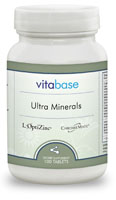| |
Manganese supplements |
|
Manganese is an essential trace nutrient in all forms of life. Manganese activates enzyme systems involved in protein and energy metabolism. Manganese is involved in connective tissue and bone formation, insulin action, and cholesterol synthesis. Manganese is vital in the bio-synthesis of collagen as it helps activate key enzymes in the formation of collagen. Manganese is a component of the antioxidant enzyme manganese superoxide dismutase (MnSOD). Antioxidants such as MnSOD can neutralize free radicals and may reduce or even help prevent some of the damage they cause. Manganese may be found in whole grains, cereals, fruits, vegetables, and tea. The total amount of manganese in the adult human is about 10-20mg, which is concentrated mainly in the liver, skeleton, pancreas, and brain.
|
| |
Biological functions and health benefits of manganese |
|
| Manganese is an essential trace mineral that is required in small amounts to manufacture enzymes necessary for the metabolism
of proteins and fat. It also supports the immune system, blood sugar balance, and is involved in the production of cellular energy, reproduction and bone growth. This micronutrient activates one or more enzymes in fatty acid synthesis. Manganese also activates the enzymes responsible for DNA and RNA production. Closely associated with copper and zinc, manganese also participates directly in the photosynthetic creation of oxygen from water. Manganese acts as a catalyst and cofactor in many enzymatic processes involved in the synthesis of fatty acids and cholesterol. Manganese aids in the formation of connective tissue, bones, blood-clotting factors, and sex hormones and plays a role in fat and carbohydrate metabolism, calcium absorption, and blood sugar regulation.
Manganese ions are able to scavenge hydroxyl and superoxide radicals. Manganese is a crucial component of the metalloenzyme manganese superoxide dismutase (MnSOD). Manganese superoxide dismutase (MnSOD) is the principal antioxidant enzyme of mitochondria and is the principal constituent of the mitochondrial oxidant defense system. Manganese is an important cofactor in the enzymes necessary for mucopolysaccharide synthesis. Mucopolysaccharide is an important constituent in both skeletal and cartilage structural matrix. Manganese is essential for the enzymatic incorporation of xylose and galactose in glycoproteins. Manganese is also involved in the transfer of high energy phosphate groups by phosphotransferase enzymes.
|
| |
Dietary sources of manganese |
|
| Rich dietary sources of manganese include nuts and seeds, wheat germ and whole grains, legumes, and pineapples. Several forms of manganese are found in supplements, including manganese gluconate, manganese sulfate, manganese ascorbate, and amino acid chelates of manganese (aspartate, picolinate, fumarate, malate, succinate, citrate, and amino acid chelate). |
| |
Manganese deficiency |
|
Low dietary manganese or low levels of manganese in blood or tissue have been associated with several chronic diseases. Signs of manganese deficiency may include serum cholesterol, depressed growth of hair and nails, scaly dermatitis, weight loss, impaired growth, impaired reproductive function, skeletal abnormalities, impaired glucose tolerance, and altered carbohydrate and lipid metabolism. People with rheumatoid arthritis tend to have low levels of superoxide dismutase. Manganese levels may be lower in people with seizure disorders. Low levels of manganese have also been associated with muscle disorders. In children, manganese deficiency can cause problems with the normal growth of the skeleton as well as balance and movement problems.
|
| |
Dosage, intake, recommended daily allowance (RDA) |
|
Because a lack of manganese is rare, there is no recommended daily allowance (RDA) for it. Usually the average intake of manganese worldwide ranges from 0.52 to 10.8 mg daily. The Institute of Medicine recommends that intake of manganese from food, water and dietary supplements should not exceed the tolerable daily upper limit of 11 mg per day because of the risk of neurological side effects.
|
| |
Side effects, precautions, toxicity, and drug interactions |
|
Manganese in excess is toxic. Exposure to manganese dusts and fumes should not exceed the ceiling value of 5 mg/m3 for even short periods because of its toxicity level. A form of Parkinson's Disease-type neurodegeneration called "manganism" has been linked to manganese exposure since the early 19th Century. Allegations of inhalation-induced manganism have been made regarding the welding industry. Listed on the Hazardous Substance List, manganese is regulated by OSHA due to its high level of toxicity. Manganese supplements are contraindicated in those with liver failure. Several minerals, such as calcium and iron, and possibly zinc, reduce the absorption of manganese. People who take oral contraceptives or antacids may require higher intake of manganese.
|
|
|
|
|
 Minerals are divided into two classes: macrominerals and trace minerals. Macrominerals are needed in larger amounts than trace minerals. Ultra Minerals by Vitabase includes the macrominerals calcium, magnesium and potassium. Important trace minerals in our supplement are iron, iodine, zinc, selenium, copper, manganese, chromium, molybdenum, vanadium and boron. Many of the minerals are chelated which means they have been bonded to a protein molecule. This helps transport them to the blood stream and enhances absorption at the cellular level. Click here for more information.
Minerals are divided into two classes: macrominerals and trace minerals. Macrominerals are needed in larger amounts than trace minerals. Ultra Minerals by Vitabase includes the macrominerals calcium, magnesium and potassium. Important trace minerals in our supplement are iron, iodine, zinc, selenium, copper, manganese, chromium, molybdenum, vanadium and boron. Many of the minerals are chelated which means they have been bonded to a protein molecule. This helps transport them to the blood stream and enhances absorption at the cellular level. Click here for more information.